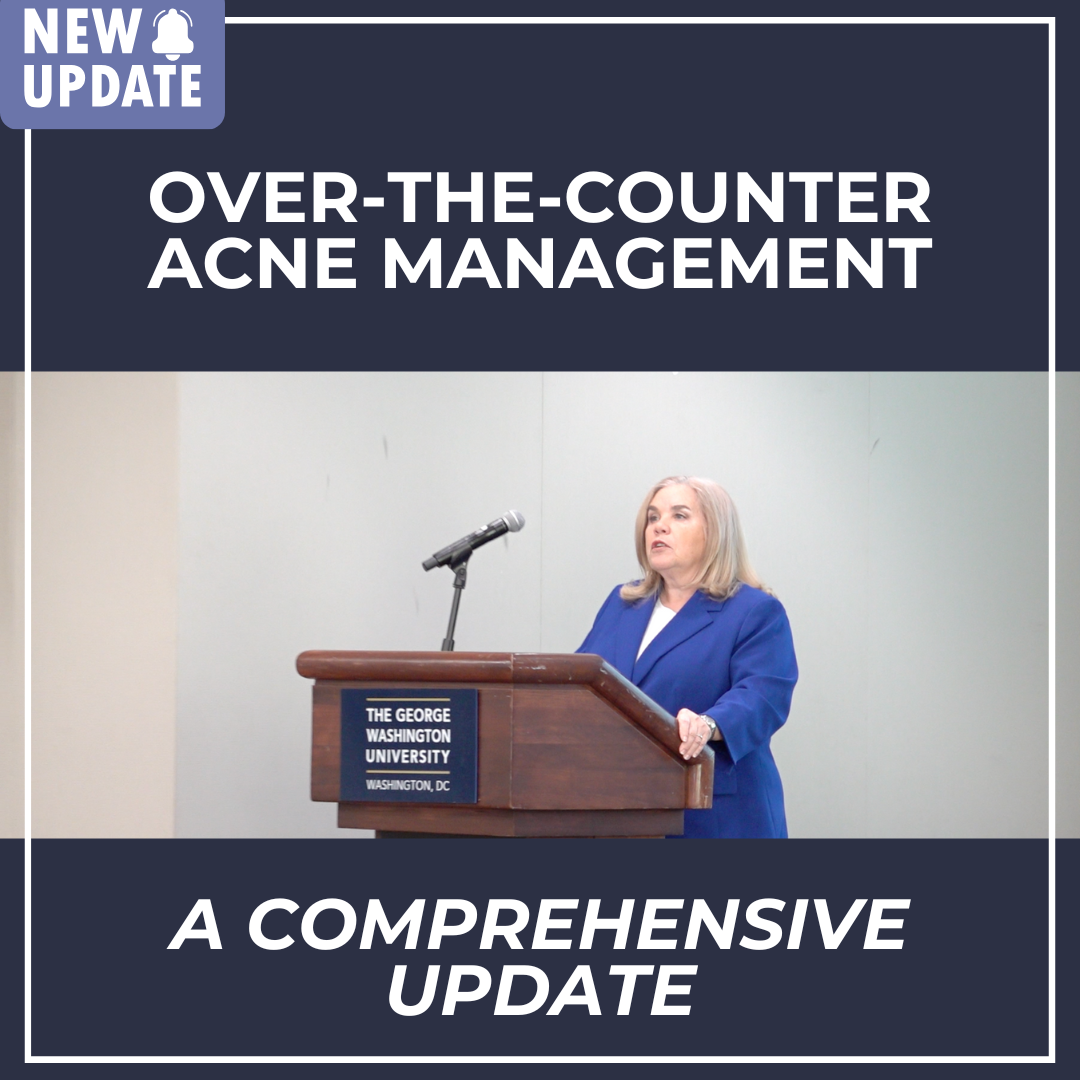The management of acne vulgaris has long included a balance between prescription and over-the-counter (OTC) therapies. OTC therapies are typically first-line treatment for most patients, and may be all that is needed to control less severe acne. At the recent Lab to Label Conference, Dr. Hilary Baldwin, a board-certified dermatologist and medical director of the Acne Treatment & Research Center in Morristown, NJ and Brooklyn, NY, shared practical pearls highlighting how to optimize OTC regimens for patients with mild-to-moderate acne.
Topical Retinoids
Topical retinoids remain the gold standard for management of all clinical flavors of acne. Adapalene 0.1% gel is the only FDA-approved OTC retinoid and is both extensively studied and well tolerated. Unlike other OTC retinol- or retinaldehyde-containing products, which may improve photoaging but lack efficacy in acne management, adapalene has demonstrated comparable efficacy to 0.25% tretinoin with significantly less irritation. The formulation’s ability to reduce both inflammatory and non-inflammatory lesions makes it ideal for a broad spectrum of patients.1,2
Despite common complaints of irritation during the initial phase of treatment, often peaking at two weeks, dubbed by Dr. Baldwin the “crisis of confidence,” there are no truly “retinoid-intolerant” patients. Rather, lack of adherence is often due to insufficient education. Clinicians should counsel patients on the process of retinization, anticipated sun sensitivity due to thinning of the stratum corneum, and the importance of continued use despite initial flares or dryness.
Benzoyl Peroxide
Benzoyl peroxide (BPO) remains one of the most effective OTC treatments for acne, particularly in addressing C. acnes colonization. As a bactericidal agent, BPO acts immediately and does not contribute to antibiotic resistance.1 Studies support the use of lower concentrations (e.g., 2.5%), which are equally effective to the 5% and 10% concentrations, but better tolerated.3 However, irritation can be minimized with formulations that include micronization or microencapsulation.
The most notable adverse effect of BPO is its ability to bleach fabrics, an often-overlooked point that can influence patient adherence. Educating patients on this risk can help manage expectations and prevent frustration with their acne regimen.
Acne as a Barrier Dysfunction Disorder
Investigations into acne pathogenesis have established that the disease involves not only inflammation and microbial overgrowth, but also impaired skin barrier function. Patients with untreated acne exhibit increased transepidermal water loss and reduced stratum corneum hydration, both of which correlate with disease severity. This dysfunction is compounded by common acne therapies that can further disrupt the skin barrier.4,5 Therefore, gentle skincare is a key component of acne management. Using a low-pH, non-stripping cleanser can help restore barrier integrity – especially important given that acne-prone individuals tend to have elevated skin pH at baseline.6 Once-daily cleansing in the evening is typically sufficient unless patients wake up in the morning with significant oiliness. Moisturizers are also essential, particularly in patients with “dry, greasy” skin. Excess sebum production can be a sign of dehydrated skin, and sebum is not a substitute for moisture.7
Addressing Post-Inflammatory Hyperpigmentation
PIH is often a greater concern than active acne lesions for patients with darker skin tones.8 Traditionally, treatment options have been limited by the risk of hypopigmentation or a halo effect when spot-treating with agents like hydroquinone. The advent of newer OTC formulations, including human tyrosinase inhibitors which bind melanin precursors, provide promising options. These innovations appear to reduce pigment in PIH lesions without affecting surrounding skin tone, allowing for broader and safer application.9,10
Product Selection
Instructing patients to choose a “gentle cleanser” or “use a non-comedogenic moisturizer” is often insufficient – the vast OTC skincare market can be overwhelming and inconsistent. Instead, dermatologists should offer brand-specific product recommendations to ensure patients select formulations that are compatible with their skin type. Samples can be particularly helpful for trial and comparison. Encouraging online ordering may help patients access the right products without becoming distracted or confused while in-store.
Final Thoughts
OTC acne products play a critical role in managing mild-to-moderate disease. They offer accessible, affordable, and often more tolerable alternatives to prescription medications. When paired with quality skincare, brand-specific guidance, and thorough patient education, these products can improve patient outcomes. No acne visit should conclude without discussing skin barrier health and providing clear instructions on cleanser and moisturizer selection. As the acne OTC monograph evolves, continued attention to formulation, tolerability, and patient priorities will help clinicians better tailor regimens and support long-term adherence.
References
-
- Zaenglein AL, Pathy AL, Schlosser BJ, Alikhan A, Baldwin HE, Berson DS, Bowe WP, Graber EM, Harper JC, Kang S, Keri JE, Leyden JJ, Reynolds RV, Silverberg NB, Stein Gold LF, Tollefson MM, Weiss JS, Dolan NC, Sagan AA, Stern M, Boyer KM, Bhushan R. Guidelines of care for the management of acne vulgaris. J Am Acad Dermatol. 2016 May;74(5):945-73.e33. doi: 10.1016/j.jaad.2015.12.037. Epub 2016 Feb 17. Erratum in: J Am Acad Dermatol. 2020 Jun;82(6):1576. doi: 10.1016/j.jaad.2020.02.010. PMID: 26897386.
- Tu P, Li GQ, Zhu XJ, Zheng J, Wong WZ. A comparison of adapalene gel 0.1% vs. tretinoin gel 0.025% in the treatment of acne vulgaris in China. J Eur Acad Dermatol Venereol. 2001;15 Suppl 3:31-6. doi: 10.1046/j.0926-9959.2001.00010.x. PMID: 11843231.
- Mills OH Jr, Kligman AM, Pochi P, Comite H. Comparing 2.5%, 5%, and 10% benzoyl peroxide on inflammatory acne vulgaris. Int J Dermatol. 1986 Dec;25(10):664-7. doi: 10.1111/j.1365-4362.1986.tb04534.x. PMID: 2948929.
- Yamamoto A, Takenouchi K, Ito M. Impaired water barrier function in acne vulgaris. Arch Dermatol Res. 1995;287(2):214-8. doi: 10.1007/BF01262335. PMID: 7763094.
- Thiboutot D, Del Rosso JQ. Acne Vulgaris and the Epidermal Barrier: Is Acne Vulgaris Associated with Inherent Epidermal Abnormalities that Cause Impairment of Barrier Functions? Do Any Topical Acne Therapies Alter the Structural and/or Functional Integrity of the Epidermal Barrier? J Clin Aesthet Dermatol. 2013 Feb;6(2):18-24. PMID: 23441236; PMCID: PMC3579484.
- Youn SH, Choi CW, Choi JW, Youn SW. The skin surface pH and its different influence on the development of acne lesion according to gender and age. Skin Res Technol. 2013 May;19(2):131-6. doi: 10.1111/srt.12023. Epub 2012 Dec 26. PMID: 23279122.
- Lain E, Andriessen AE. Choosing the Right Partner: Complementing Prescription Acne Medication With Over-the-Counter Cleansers and Moisturizers. J Drugs Dermatol. 2020 Nov 1;19(11):1069-1075. doi: 10.36849/JDD.2020.5536. PMID: 33196748.
- Callender VD, Baldwin H, Cook-Bolden FE, Alexis AF, Stein Gold L, Guenin E. Effects of Topical Retinoids on Acne and Post-inflammatory Hyperpigmentation in Patients with Skin of Color: A Clinical Review and Implications for Practice. Am J Clin Dermatol. 2022 Jan;23(1):69-81. doi: 10.1007/s40257-021-00643-2. Epub 2021 Nov 9. PMID: 34751927; PMCID: PMC8776661.
- Mann T, Gerwat W, Batzer J, Eggers K, Scherner C, Wenck H, Stäb F, Hearing VJ, Röhm KH, Kolbe L. Inhibition of Human Tyrosinase Requires Molecular Motifs Distinctively Different from Mushroom Tyrosinase. J Invest Dermatol. 2018 Jul;138(7):1601-1608. doi: 10.1016/j.jid.2018.01.019. Epub 2018 Feb 7. PMID: 29427586.
- Zolghadri S, Bahrami A, Hassan Khan MT, Munoz-Munoz J, Garcia-Molina F, Garcia-Canovas F, Saboury AA. A comprehensive review on tyrosinase inhibitors. J Enzyme Inhib Med Chem. 2019 Dec;34(1):279-309. doi: 10.1080/14756366.2018.1545767. PMID: 30734608; PMCID: PMC6327992.
About the author
 Savanna Vidal is a medical student and pre-doctoral research fellow in the Department of Dermatology at the George Washington University School of Medicine and Health Sciences.
Savanna Vidal is a medical student and pre-doctoral research fellow in the Department of Dermatology at the George Washington University School of Medicine and Health Sciences.
Did you enjoy this article? You can find more on Medical Dermatology here.

